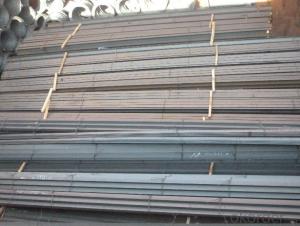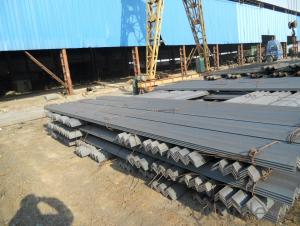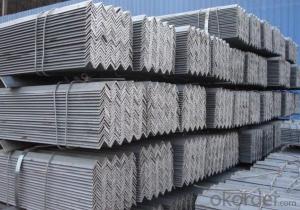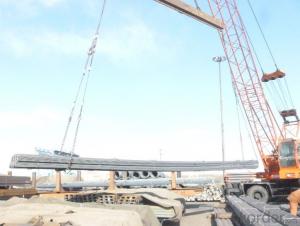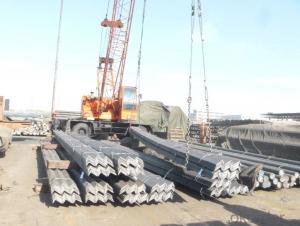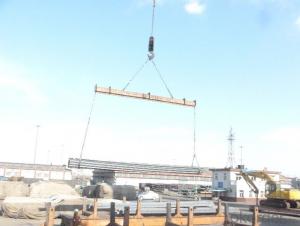angle steel
- Loading Port:
- China Main Port
- Payment Terms:
- TT OR LC
- Min Order Qty:
- -
- Supply Capability:
- -
OKorder Service Pledge
OKorder Financial Service
You Might Also Like
Product Description:
Specifications of Angle Steel
1. Invoicing on theoretical weight or actual weight as customer request
2. Length: 6m, 9m, 12m as following table
3. Sizes
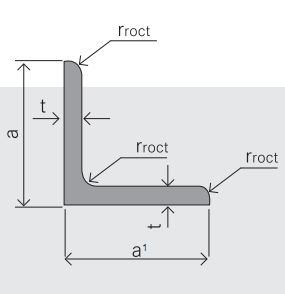
Sizes: 25mm-250mm | ||
a*t | ||
25*2.5-4.0 | 70*6.0-9.0 | 130*9.0-15 |
30*2.5-6.6 | 75*6.0-9.0 | 140*10-14 |
36*3.0-5.0 | 80*5.0-10 | 150*10-20 |
38*2.3-6.0 | 90*7.0-10 | 160*10-16 |
40*3.0-5.0 | 100*6.0-12 | 175*12-15 |
45*4.0-6.0 | 110*8.0-10 | 180*12-18 |
50*4.0-6.0 | 120*6.0-15 | 200*14-25 |
60*4.0-8.0 | 125*8.0-14 | 250*25 |
5. Payment terms:
1).100% irrevocable L/C at sight.
2).30% T/T prepaid and the balance against the copy of B/L.
3).30% T/T prepaid and the balance against L/C
6.Material details:
Alloy No | Grade | Element (%) | | ||||
C | Mn | S | P | Si | | ||
| | |||||||
|
|
|
|
|
|
| |
Q235 | B | 0.12—0.20 | 0.3—0.7 | ≤0.045 | ≤0.045 | ≤0.3 | |
|
|
|
|
|
|
| |
Alloy No | Grade | Yielding strength point( Mpa) | | ||||
Thickness (mm) | | ||||||
≤16 | >16--40 | >40--60 | >60--100 | | |||
≥ | | ||||||
|
|
|
|
|
| | |
Q235 | B | 235 | 225 | 215 | 205 | | |
Alloy No | Grade | Tensile strength (Mpa) | Elongation after fracture (%) | | |||
Thickness (mm) | | ||||||
| ≤16 | >16--40 | >40--60 | >60--100 | | ||
≥ | | ||||||
|
|
|
|
|
|
| |
Q235 | B | 375--500 | 26 | 25 | 24 | 23 | |
Usage & Applications of Angle Steel
According to the needs of different structures, Angle can compose to different force support component, and also can be the connections between components. It is widely used in various building structures and engineering structures such as roof beams, bridges, transmission towers, hoisting machinery and transport machinery, ships, industrial furnaces, reaction tower, container frame and warehouse etc.
Packaging & Delivery of Angle Steel
1. Packing: it is nude packed in bundles by steel wire rod
2. Bundle weight: not more than 3.5MT for bulk vessel; less than 3 MT for container load
3. Marks:
Color marking: There will be color marking on both end of the bundle for the cargo delivered by bulk vessel. That makes it easily to distinguish at the destination port.
Tag mark: there will be tag mark tied up on the bundles. The information usually including supplier logo and name, product name, made in China, shipping marks and other information request by the customer.
If loading by container the marking is not needed, but we will prepare it as customer request.
Production flow of Angle Steel
Material prepare (billet) —heat up—rough rolling—precision rolling—cooling—packing—storage and transportation

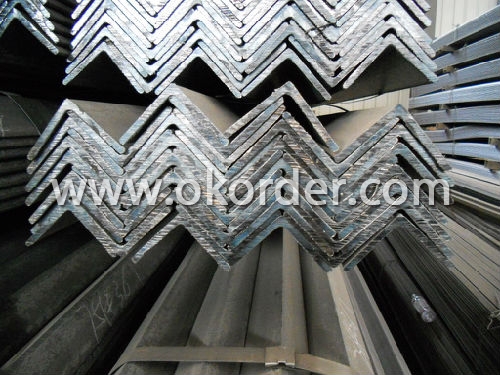
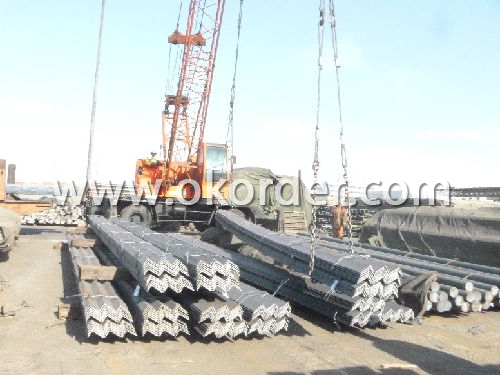
- Q: How do steel angles compare to other structural shapes?
- Steel angles are a versatile and commonly used structural shape in construction and engineering. They have several advantages over other structural shapes, such as beams or channels. Firstly, steel angles offer excellent strength and stability. Their L-shaped design provides rigidity and support, making them ideal for load-bearing applications. They can effectively resist both compressive and tensile forces, making them suitable for a wide range of structural applications. Secondly, steel angles have a compact and space-saving profile. Unlike other structural shapes like beams or channels, angles have a smaller cross-sectional area, making them more efficient in terms of material usage. This can result in cost savings and reduced weight in construction projects. Moreover, steel angles are highly adaptable and can be easily customized to fit specific project requirements. They can be cut, welded, drilled, and modified without compromising their structural integrity. This flexibility allows for easy integration into various structural systems and applications. Additionally, steel angles offer versatility in terms of their connection options. They can be bolted, welded, or riveted, providing flexibility in joining them with other structural components. This makes them suitable for a wide range of building and construction projects. Finally, steel angles are readily available and cost-effective. They are widely produced and stocked by steel manufacturers, making them easily accessible. Their affordability, combined with their durability and strength, makes them a popular choice for structural applications. In summary, steel angles compare favorably to other structural shapes due to their strength, space-saving design, adaptability, connection options, and cost-effectiveness. Their versatility and performance make them a preferred choice in various construction and engineering projects.
- Q: Can steel angles be used in modular or prefabricated construction?
- Yes, steel angles can be used in modular or prefabricated construction. Steel angles are commonly used as structural components in construction due to their strength and versatility. They can be easily fabricated and integrated into modular or prefabricated building systems, allowing for efficient and cost-effective construction processes. Steel angles can be used to provide structural support, reinforce connections, and create framing systems in modular or prefabricated buildings. Additionally, their ability to be customized and adapted to various design requirements makes them suitable for a wide range of building applications in the modular or prefabricated construction industry.
- Q: Are steel angles resistant to UV radiation or fading?
- Steel angles do not possess inherent resistance to UV radiation or fading. Due to the properties of steel, it is prone to oxidation and corrosion when exposed to UV radiation and atmospheric conditions. As time passes, the steel can fade, lose its shine, and acquire a patina due to the UV radiation. Nevertheless, measures can be implemented to reduce the impact of UV radiation on steel angles. The application of protective coatings, such as paint or galvanizing, can serve as a shield against UV radiation and aid in preventing fading. Additionally, regular maintenance and proper care can prolong the lifespan and improve the appearance of steel angles when subjected to UV radiation.
- Q: How do you prevent and address corrosion in steel angles?
- To prevent and address corrosion in steel angles, several measures can be taken. Firstly, applying a protective coating such as paint or galvanization can create a barrier between the steel and corrosive elements. Regular maintenance and inspection are also crucial to identify and address any signs of corrosion early on. Additionally, keeping the steel angles clean and dry, and avoiding contact with corrosive substances, can significantly reduce the risk of corrosion. Implementing proper drainage and ventilation systems in areas where steel angles are installed can also help prevent moisture buildup, which is a common cause of corrosion.
- Q: What are the weight per meter calculations for steel angles?
- The weight per meter calculations for steel angles depend on the dimensions of the angle and the density of the steel being used. To calculate the weight per meter of a steel angle, you need to know the dimensions of the angle, specifically the thickness, width, and length. The formula to calculate the weight per meter is: Weight per meter = (Thickness x Width x Length) x Density The density of steel varies depending on the type of steel being used. The most common type of steel used for angles is mild steel, which has a density of approximately 7.85 grams per cubic centimeter (g/cm³) or 7850 kilograms per cubic meter (kg/m³). For example, let's say we have a steel angle with a thickness of 10 millimeters (mm), a width of 100 mm, and a length of 1 meter (1000 mm). Using the formula and assuming a density of 7850 kg/m³, the weight per meter would be: Weight per meter = (10 mm x 100 mm x 1000 mm) x 7850 kg/m³ Weight per meter = 10,000,000 mm³ x 7850 kg/m³ Weight per meter = 78,500,000,000 mm³/kg To convert the weight to a more common unit, we can divide by 1,000,000 to get the weight per meter in kilograms: Weight per meter = 78,500,000,000 mm³/kg / 1,000,000 Weight per meter = 78,500 kg/m Therefore, the weight per meter of this steel angle would be 78,500 kilograms.
- Q: Do steel angles require any special maintenance?
- No special maintenance is needed for steel angles, but their lifespan can be prolonged with proper care and attention. It is recommended to regularly clean them to remove dirt, debris, and corrosive substances. Additionally, it is important to promptly address any signs of rust, cracks, or damage to prevent further deterioration. To prevent corrosion and extend the life of the steel angles, applying a protective coating or paint is advisable. In general, steel angles require minimal maintenance, but regular inspections and maintenance practices are crucial for optimal performance and longevity.
- Q: How do you prevent steel angles from vibrating?
- There are several ways to prevent steel angles from vibrating: 1. Damping materials: Applying damping materials such as rubber pads, neoprene, or foam between the steel angles and the structure they are attached to can help absorb and dissipate vibrations. 2. Structural modifications: Reinforcing the steel angles by adding additional supports or bracing can help reduce vibrations. By increasing the stiffness and rigidity of the structure, the tendency for vibrations to occur can be minimized. 3. Mass modification: Adding additional mass to the steel angles can help stabilize them and reduce vibrations. This can be achieved by attaching weight plates or heavier components to the angles. 4. Tensioning: Applying tension to the steel angles can help reduce vibrations by increasing their natural frequency and stiffness. This can be done by tightening bolts or using tensioning devices. 5. Vibration isolation: Using vibration isolation techniques, such as mounting the steel angles on rubber isolators or spring mounts, can help isolate them from the surrounding structure and minimize vibration transmission. 6. Resonance avoidance: Identifying and avoiding the natural frequencies of the steel angles is crucial in preventing vibrations. By analyzing the structural dynamics and adjusting the design or operational conditions, resonance can be avoided, reducing the chances of vibrations. 7. Regular maintenance: Regularly inspecting and maintaining the steel angles can help identify any issues or potential sources of vibrations. This includes checking for loose connections, corrosion, or any signs of wear and tear that could contribute to vibration problems. It is important to note that the specific method(s) chosen to prevent steel angles from vibrating will depend on various factors, including the application, structural design, and environmental conditions. Consulting with a structural engineer or vibration specialist is recommended to ensure the most effective and appropriate solution is implemented.
- Q: How do you calculate the torsional strength of a steel angle?
- The torsional strength of a steel angle can be calculated by determining the moment of inertia of the angle cross-section and then applying the torsion formula, which relates the applied torque to the torsional stress and the polar moment of inertia.
- Q: How do steel angles perform under high temperatures?
- Steel angles perform well under high temperatures as they have a high melting point and exhibit good thermal conductivity. They retain their strength and structural integrity, making them suitable for use in various applications such as construction, manufacturing, and industrial processes that involve elevated temperatures.
- Q: How are steel angles protected against abrasion?
- Steel angles find common applications in construction and industrial settings, where they are exposed to various forms of abrasion. To safeguard steel angles against abrasion, multiple techniques are employed. One prevalent approach involves the use of protective coatings, such as paints, epoxy coatings, or specialized coatings designed for abrasion resistance. These coatings act as a barrier between the steel surface and abrasive elements, preventing direct contact and minimizing wear caused by friction. Another method entails the application of rubber or plastic linings to the susceptible surfaces of steel angles. These linings absorb the impact of abrasive forces, cushioning the steel and reducing wear. Additionally, they provide an extra layer of protection against corrosion and chemical attacks. In certain cases, steel angles may undergo hardening or heat treatment. This process involves subjecting the steel to high temperatures followed by rapid cooling, altering the steel's microstructure to enhance hardness and resistance to abrasion. Heat-treated steel angles are commonly used in industries with high-wear environments, such as mining and material handling. Furthermore, engineers may choose to design steel angles with specific profiles or shapes that offer improved resistance to abrasion. These profiles may include rounded edges, chamfers, or other features that minimize direct contact with abrasive materials. Overall, protecting steel angles from abrasion involves a combination of protective coatings, linings, heat treatment, and thoughtful design. Implementing these measures significantly prolongs the lifespan and performance of steel angles, reducing maintenance costs and ensuring durability in abrasive environments.
Send your message to us
angle steel
- Loading Port:
- China Main Port
- Payment Terms:
- TT OR LC
- Min Order Qty:
- -
- Supply Capability:
- -
OKorder Service Pledge
OKorder Financial Service
Similar products
Hot products
Hot Searches
Related keywords
